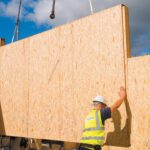Grounding Your Dreams: Exploring Diverse Foundations in Building Design
Foundations are critical components in construction, providing support for buildings and transferring their loads to the underlying soil or bedrock. Several types of foundations are used in construction, each suited to specific site conditions and building requirements.
Here are common types of foundations:
Following are different types of foundations used in construction:
Shallow Foundations:
Spread Footings: These are the most common type of shallow foundation. They distribute the building’s load over a wider area of soil and are often used for individual columns.
Mat or Raft Foundations: A thick, reinforced concrete slab that covers the entire building footprint. Mat foundations are used to distribute heavy loads and reduce settlement.
Deep Foundations:
Pile Foundations: These involve driving or drilling long, slender piles deep into the soil or bedrock. Piles provide support for structures in areas with weak or compressible soils.
Pier Foundations: Like pile foundations, but piers are typically larger and are used to support heavy structures like bridges and high-rise buildings.
Caisson Foundations: These are large, watertight structures that are either floated to the construction site or sunk into place, often used in marine construction or deep excavations.
Slab-on-Grade Foundations:
A concrete slab poured directly on the ground surface, typically used for residential construction, garages, and smaller structures.
Crawl Space Foundations:
Raised foundations that provide a crawl space beneath the building. Common in residential construction, they allow access to utilities and can help with insulation.
Basement Foundations:
Full or partial underground foundations used to create habitable spaces below ground level. Basements are common in residential and commercial buildings.
Trench Foundations:
Long, narrow excavations filled with concrete. Trench foundations are used for retaining walls, fences, and small structures.
Isolated Foundations:
Used for individual columns or posts to support structures like houses, small buildings, or equipment.
Continuous Wall Foundations: A continuous strip or wall of concrete that supports the load-bearing walls of a building.
Floating Foundations:
Used in areas with expansive soils. These foundations "float" on the soil surface to mitigate the effects of soil movement.
Mud Mat Foundations:
Used in swampy or waterlogged areas, mud mat foundations distribute the building’s load over a wider area to prevent settling.
Screw Pile Foundations:
Utilize screw-like helical plates to anchor the foundation into the soil. They are often used for lightweight structures, decks, or temporary buildings.
The choice of foundation type is influenced by various elements, including the soil composition, building load, regional climate, and cost of construction. To choose the best form of foundation for a particular project and ensure the safety and stability of the structure, engineers carefully analyze these variables.
Disclaimer: This content is provided solely for your review. Erusu Consultants takes no liability for this article. The reader is advised to form their own opinion. Please consult a Structural Engineer before making any final decisions.






